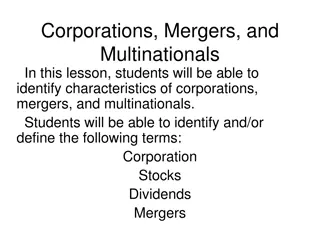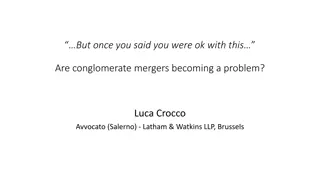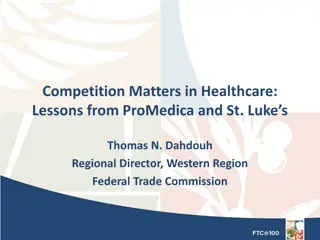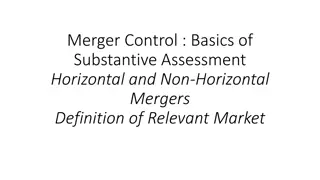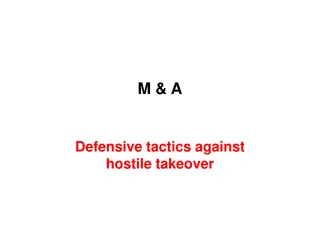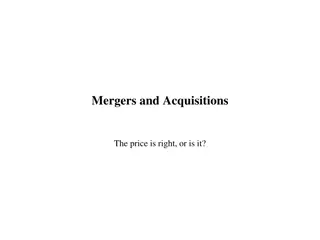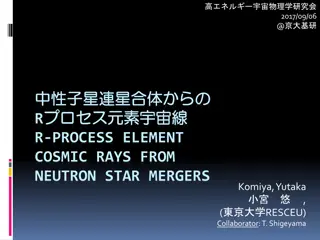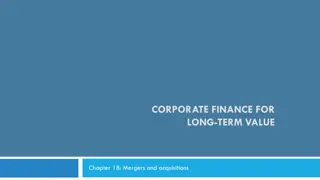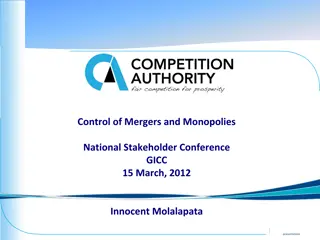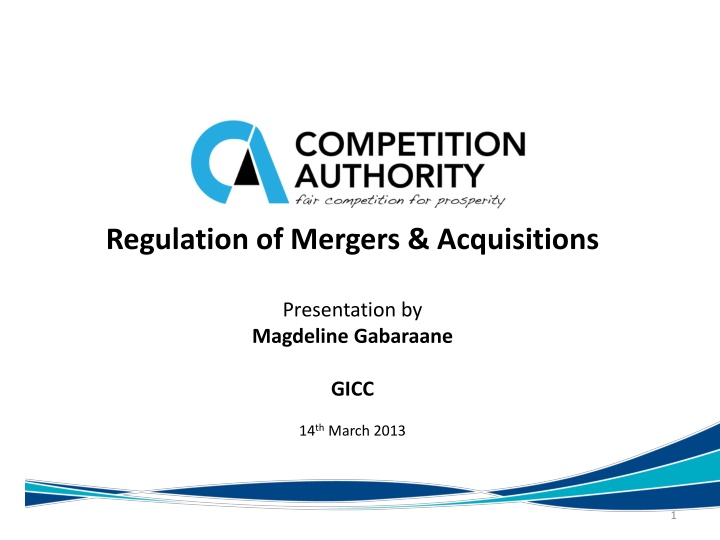
Regulation of Mergers and Acquisitions in Business
Explore the importance of regulating mergers, the definition of a merger, the process of acquisition of control, and the competitive effects of mergers. Learn about the control process, notification requirements, and assessment procedures in the context of mergers and acquisitions. Discover why market concentration and anti-competitive behaviors are key considerations in merger regulation.
Uploaded on | 1 Views
Download Presentation

Please find below an Image/Link to download the presentation.
The content on the website is provided AS IS for your information and personal use only. It may not be sold, licensed, or shared on other websites without obtaining consent from the author. If you encounter any issues during the download, it is possible that the publisher has removed the file from their server.
You are allowed to download the files provided on this website for personal or commercial use, subject to the condition that they are used lawfully. All files are the property of their respective owners.
The content on the website is provided AS IS for your information and personal use only. It may not be sold, licensed, or shared on other websites without obtaining consent from the author.
E N D
Presentation Transcript
Regulation of Mergers & Acquisitions Presentation by Magdeline Gabaraane GICC 14thMarch 2013 1
PRESENTATION OUTLINE 1. Why regulate mergers 2. Merger definition 3. Merger control process 4. Competitive effects of mergers 5. Conclusions
Why regulate mergers - Mergers between firms may produce positive and negative effects on the economy. Market concentration may, by reducing the number of participants in the market, make the adoption of anti- competitive behaviours (price raises, quality reduction, diminished variety or reduced innovations) easier.
Definition A merger occurs when (S52(1)) one or more enterprises directly or indirectly acquires or establishes direct or indirect control over the whole or part of the business of another enterprise .
Acquisition of control over the whole or a part of another enterprise may be achieved when:- A business buys shares, leases shares, an interest or assets from another business, or two/more businesses combine or amalgamate
Merger control process Merger control process Merger Notification Merger Assessment Merger Determination
Merger Notification Process Turnover in Botswana of the enterprise or enterprises being taken over > P10 million Assets in Botswana of the enterprise or enterprises being taken over > P 10 million; or Mergers and acquisitions falling within these thresholds are required to notify their transactions with the Authority Enterprises concerned would, following implementation of the merger have a market share of at least 20 percent of a particular description of goods or services in Botswana. 7
Merger Assessement Process Preventing/lessening competition in the relevant market Any enterprise acquiring a dominant position in the market In-depth merger analysis (economic and legal aspects) undertaken to ascertain effect of transaction on.. Whether the proposed merger would have any public benefits/public interest concerns 8
Merger Determination Authorise the merger, without conditions; Authorise the merger, subject to conditions the Authority considers necessary and reasonable to prevent/lessen any adverse effects of the merger; or Merger determination is made to Decline the merger if it would result in anticompetitive effects 9
Notified Mergers From inception, the CA has assessed 45 mergers and acquisitions 21 (46%) of these were approved with conditions 17 (37%) were approved unconditionally 4 (8%) were declined, 2 later reached settlements 3 assessment on-going 10
Conditional approvals Approval conditions and undertakings have been in the areas of:- Preserving employment Citizen empowerment Technical and technological transfer and training Capacity building 11
Not all mergers give rise to competition issues. Some mergers are pro-competitive (because they positively enhance the level of competition). Other mergers lessen competition but not substantially, because sufficient post-merger competitive constraints exist to ensure that competition continues to discipline the commercial behaviour of the merged entity.
Competitive Effects of Mergers The assessment of whether a merger or acquisition is likely to prevent or substantially lessen competition considers the following:- Removal of an effective or potential competitor Existence of import or foreign competition Industry barriers to entry and expansion Unilateral effects Foreclosure Countervailing buyer power 13
CA may determine whether a merger can or cannot be justified on public interest grounds 1. Employment creation 2. Export promotion 3. Industrial/economic development 4. Improve, or prevent a decline in the production or distribution of goods or the provision of services 5. Advance citizen empowerment initiatives or enhance the competitiveness of citizen- owned small and medium sized enterprises
Assessed mergers per sector The distribution of M&A s assessed by the Authority, per sector Insurance 11% Other 11% Energy 14% Agriculture 7% Mining 18% Healthcare 11% Manufacturin g 10% Construction 7% Wholesale & Retail 11% 15
Conclusions The Competition Authority will continue to regulate mergers & acquisitions with the potential to lessen competition by reducing or weakening the competitive pressure or reducing the incentives for competitive rivalry. The Authority shall promote transactions that enable the merged firm to meet customer demand in a way that facilitates more intense competition. The CA will continuously engage with the business community and other key stakeholders in the execution of its mandate. 16



